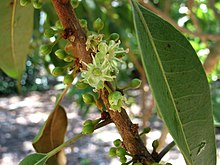Biology
provided by Arkive
The scented flowers of the island nesoluma are unisexual, with male and female flowers occurring on separate plants (2). The olive-shaped fruits are produced in large numbers from May to September (3).
Conservation
provided by Arkive
Habitat conservation is the key to the survival of the island nesoluma (8). To date the success of planting cultivated plants in the wild has been limited (7). Hawaii has a number of protected areas where the island nesoluma grows, including the Kanaio Natural Area Reserve (NAR) (8) and Kuia NAR (4). As a whole, dryland forests in Hawaii are endangered and without careful management may completely disappear within the next few decades (8).
Description
provided by Arkive
This easily identifiable, small evergreen grows up to 10 metres tall and about 25 centimetres in diameter (2). The leaves are broadly elliptical with a shiny green, hairless upper surface and rust-coloured hairs covering the lower surface (2) (3). The twigs are also covered with rust-coloured hairs, while the bark on the trunk is grey, rough and thick, becoming furrowed into rectangular plates, and the sap is milky (3). Many fragrant flowers are produced at the base of the leaves and the flowers (3). The dark purple or brown fruits of the island nesoluma are one to two centimetres long and look similar to olives (2) (3).
Habitat
provided by Arkive
Occurs in lowland dry forest, particularly on lava flows, generally between 130 to 640 metres above sea level (2).
Range
provided by Arkive
The island nesoluma inhabits a number of Pacific islands including the Cook Islands, Tubuai Island (French Polynesia) and the Hawaiian Islands (1). Subpopulations are known from the Tubuai Group, on Raivavae, Rurutu and Rapa, on all the main Hawaiian Islands with the exception of Niihau and Kahoolawe, and are thought to grow on Mauke in the Cook Islands (1).
Status
provided by Arkive
Classified as Vulnerable (VU) on the IUCN Red List 2007 (1).
Threats
provided by Arkive
The main threat facing the island nesoluma is habitat loss and degradation from development and agriculture, especially trampling and grazing by goats and pigs (1) (4). Subpopulations on Raivavae and Rurutu are particularly vulnerable to local extinction and in Hawaii, the island nesoluma, which once formed a significant part of lowland dry forest, is now restricted to remaining patches of forest on lava flows and slopes that are less appealing for cultivation or grazing (1). A number of introduced species pose a threat to native Hawaiian plant species such as the island nesoluma. The introduction of rodents has resulted in a high level of seed predation (5), and aphids may also be having a profound impact through direct damage and through the transmission of disease (6).
Sideroxylon polynesicum
provided by wikipedia EN
- license
- cc-by-sa-3.0
- copyright
- Wikipedia authors and editors
Sideroxylon polynesicum: Brief Summary
provided by wikipedia EN

The fruit is inedible and very sticky
Sideroxylon polynesicum, the keahi or island nesoluma, is a species of flowering plant in the family Sapotaceae. It is found in the Cook (New Zealand), Tubuai (French Polynesia), and Hawaiian Islands (United States). It is threatened by habitat loss.
- license
- cc-by-sa-3.0
- copyright
- Wikipedia authors and editors


 The fruit is inedible and very sticky
The fruit is inedible and very sticky